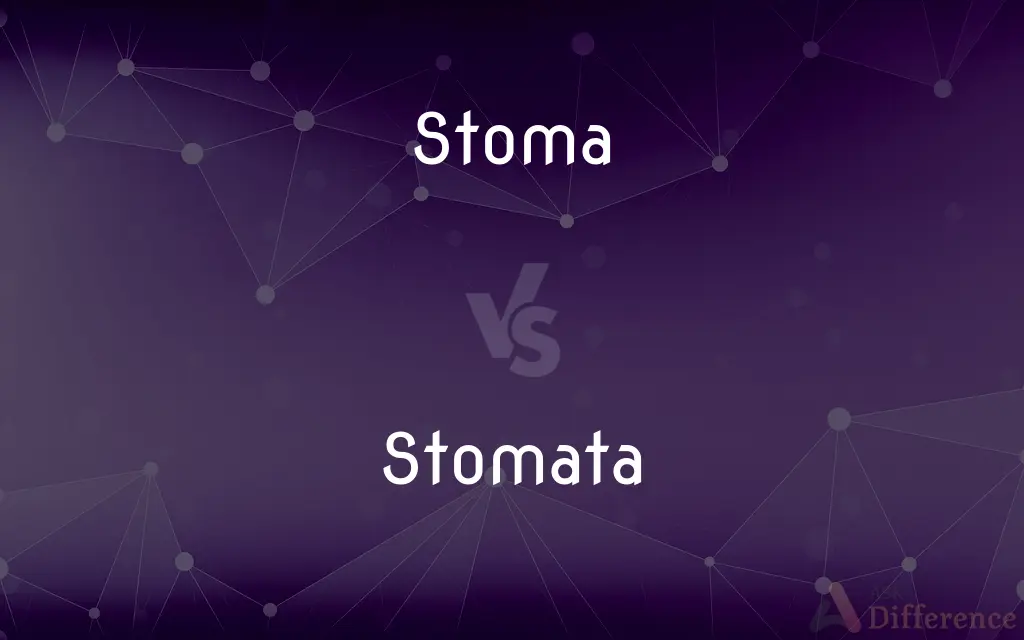Stoma vs. Stomata — What's the Difference?
Edited by Tayyaba Rehman — By Fiza Rafique — Updated on September 25, 2023
Stoma refers to a single pore-like opening primarily found in plant leaves for gas exchange, while Stomata is the plural form, referring to multiple such openings. Both are critical for photosynthesis, respiration, and transpiration in plants.

Difference Between Stoma and Stomata
Table of Contents
ADVERTISEMENT
Key Differences
Stoma is a singular term referring to a small opening or pore that is primarily found on the epidermis of leaves, stems, and other plant organs. These pores play a crucial role in the process of gas exchange, facilitating the movement of carbon dioxide, oxygen, and water vapor. On the other hand, Stomata refers to more than one such opening. When we discuss the collective role these openings play in plant physiology, the term "stomata" is commonly used.
In terms of structure, a single stoma is made up of two specialized parenchyma cells known as guard cells that regulate its opening and closing. The guard cells control the stoma's size depending on the plant's needs and environmental conditions. Stomata, as the plural form, implies the presence of multiple such structures. Each stoma functions independently, but the cumulative effect of all stomata determines the plant's ability to perform gas exchange and regulate water loss.
Grammatically speaking, the word "stoma" is a singular noun, and "stomata" is its plural form. While you would refer to a single pore as a stoma, you would use the term "stomata" to discuss multiple pores. In scientific literature, it's common to encounter both terms, depending on whether the focus is on an individual pore or on multiple pores as a system.
Both stoma and stomata are derived from the Greek word 'stoma,' meaning 'mouth,' reflecting their function as openings. While the term stoma is also used in other contexts, like medicine, to describe any small opening on the body, in botany, it specifically refers to the opening for gas exchange. Stomata, being plural, is used exclusively to describe multiple such botanical openings.
Comparison Chart
Number
Singular
Plural
ADVERTISEMENT
Cell Structure
Made of two guard cells
Multiple sets of two guard cells
Grammatical Number
Singular noun
Plural noun
Focus in Discussion
Often on individual pore
Usually on multiple pores
Role
Gas exchange, transpiration
Cumulative role in gas exchange and transpiration
Compare with Definitions
Stoma
Stoma is surrounded by two guard cells.
Guard cells regulate the opening and closing of the stoma.
Stomata
Stomata are involved in respiration.
Stomata are essential for the plant's respiratory processes.
Stoma
Stoma is a singular pore on a plant's leaf.
The stoma allows for gas exchange.
Stomata
Stomata are multiple pores on a plant's leaf.
The stomata are responsible for the plant's gas exchange.
Stoma
Stoma helps in respiration.
Oxygen and carbon dioxide flow through the stoma during respiration.
Stomata
Stomata help regulate water loss.
The opening and closing of stomata control water loss from the plant.
Stoma
Stoma is involved in transpiration.
Water vapor escapes through the stoma during transpiration.
Stomata
Stomata consist of sets of guard cells.
Guard cells surround each of the stomata.
Stoma
In botany, a stoma (from Greek στόμα, "mouth", plural "stomata"), also called a stomate (plural "stomates") is a pore, found in the epidermis of leaves, stems, and other organs, that controls the rate of gas exchange. The pore is bordered by a pair of specialized parenchyma cells known as guard cells that are responsible for regulating the size of the stomatal opening.
Stomata
Stomata facilitate photosynthesis.
Stomata allow carbon dioxide to enter, enabling photosynthesis.
Stoma
Any of the minute pores in the epidermis of the leaf or stem of a plant, forming a slit of variable width which allows movement of gases in and out of the intercellular spaces.
Stomata
A plural of stoma.
Stoma
An artificial opening made into a hollow organ, especially one on the surface of the body leading to the gut or trachea.
Stoma
(Botany) One of the minute pores in the epidermis of a leaf or stem through which gases and water vapor pass. Also called stomate.
Stoma
(Anatomy) A small aperture in the surface of a membrane.
Stoma
A surgically constructed opening, especially one in the abdominal wall that permits the passage of waste after a colostomy or ileostomy.
Stoma
(Zoology) A mouthlike opening, such as the oral cavity of a nematode.
Stoma
(botany) One of the tiny pores in the epidermis of a leaf or stem through which gases and water vapor pass.
Stoma
(medicine) A small opening in a membrane; a surgically constructed opening, especially one in the abdominal wall that permits the passage of waste after a colostomy or ileostomy.
Stoma
(zoology) A mouthlike opening, such as the oral cavity of a nematode.
Stoma
An artificial anus.
Stoma
One of the minute apertures between the cells in many serous membranes.
Stoma
The minute breathing pores of leaves or other organs opening into the intercellular spaces, and usually bordered by two contractile cells.
Stoma
A minute epidermal pore in a leaf or stem through which gases and water vapor can pass
Stoma
A mouth or mouthlike opening (especially one created by surgery on the surface of the body to create an opening to an internal organ)
Stoma
Stoma is critical for photosynthesis.
Carbon dioxide enters through the stoma to fuel photosynthesis.
Common Curiosities
What is the primary function of a stoma?
The primary function of a stoma is to facilitate gas exchange in plants.
Is a stoma made of a single cell?
No, a stoma is made of two specialized guard cells.
What regulates the size of a stoma?
The size of a stoma is regulated by two guard cells.
Do stomata also regulate water loss?
Yes, stomata play a role in regulating transpiration, or water loss, in plants.
Does each stoma function independently?
Yes, each stoma functions independently, regulated by its own set of guard cells.
What gases do stomata exchange?
Stomata exchange carbon dioxide, oxygen, and water vapor.
Is "stomata" the plural of "stoma"?
Yes, "stomata" is the plural form of "stoma."
Can you see a stoma without a microscope?
A stoma is usually too small to see without a microscope.
Are stomata found only in leaves?
Stomata are primarily found in leaves but can also occur on stems and other plant organs.
Is the term "stoma" used in other sciences?
Yes, "stoma" is also used in medicine to describe small openings on the body.
Where does the word "stoma" come from?
The word "stoma" is derived from the Greek word for 'mouth.'
Can the number of stomata vary between plants?
Yes, the number of stomata can vary depending on the plant species and environmental factors.
Are all stomata the same size?
No, the size of stomata can vary depending on the plant species and environmental conditions.
What is the primary role of stomata?
The primary role of stomata is to facilitate gas exchange and regulate water loss in plants.
Are stomata open all the time?
No, stomata open and close depending on environmental conditions and the plant's needs.
Share Your Discovery

Previous Comparison
Arthralgia vs. Arthritis
Next Comparison
Quadfecta vs. TrifectaAuthor Spotlight
Written by
Fiza RafiqueFiza Rafique is a skilled content writer at AskDifference.com, where she meticulously refines and enhances written pieces. Drawing from her vast editorial expertise, Fiza ensures clarity, accuracy, and precision in every article. Passionate about language, she continually seeks to elevate the quality of content for readers worldwide.
Edited by
Tayyaba RehmanTayyaba Rehman is a distinguished writer, currently serving as a primary contributor to askdifference.com. As a researcher in semantics and etymology, Tayyaba's passion for the complexity of languages and their distinctions has found a perfect home on the platform. Tayyaba delves into the intricacies of language, distinguishing between commonly confused words and phrases, thereby providing clarity for readers worldwide.














































